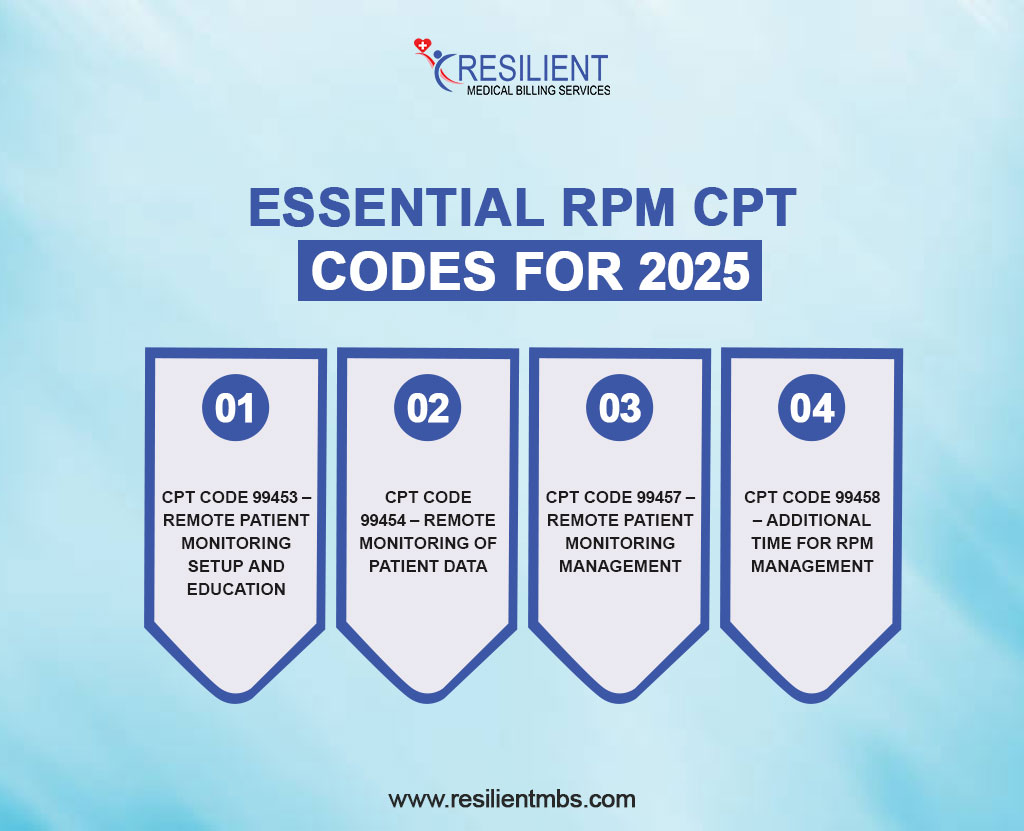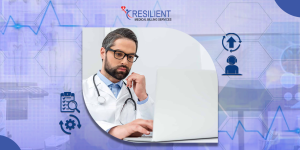RPM technology is bringing constructive change to the future of healing for both patients and healthcare workers. Research And Markets has projected that the RPM market would rise at a CAGR of 27.6% during the period 2020 to 2027 because of the increasing demand for remote healthcare services for chronic diseases.
RPM reduces hospital readmissions by 50% and healthcare costs by 20-30%, according to studies. However, trustworthy billing systems are essential to pay healthcare workers accurately and efficiently as RPM becomes more common.
Another research from the Health Affairs indicated that RPM providers need to be paid hence the need to get accurate coding and reimbursement. For accurate billing and reimbursement and fair compliance with the rules of Remote patient Monitoring CPT Codes for 2025 and CPT codes must be comprehended. Learn more on ways to adapt to these changes to effectively manage your income cycle.
What is Remote Patient Monitoring?
Remote Patient Monitoring (RPM) collects health data digitally. Blood pressure cuffs, glucose monitors, and wearable ECGs give doctors data. RPM enables monitoring and early care for chronic diseases like diabetes, hypertension, and heart disease without hospitalization. Modern healthcare needs RPM to improve patient engagement, results, and hospital readmissions.
What are CPT Codes and How are They Used in Healthcare?
CPT (Current Procedural Terminology) codes are a standardized set of codes used by healthcare providers to describe medical, surgical, and diagnostic procedures and services.
The codes are maintained by the American Medical Association (AMA) and updated regularly to reflect new advancements in medicine and healthcare.
Remote Patient Monitoring CPT Codes
Remote Patient Monitoring CPT codes are a subset of these standardized codes specifically designed to describe services related to the monitoring of patients outside of traditional clinical settings.
Telehealth providers need these codes to get reimbursed for remote care. RPM codes allow clinicians to get paid for their monitoring services, improving patient outcomes and access to care.
What Makes RPM CPT Codes Different from Other Similar Healthcare Codes
There are several ways in which RPM codes are different from other healthcare codes, like E/M (Evaluation and Management) codes or remote codes. E/M codes usually refer to visits, either in person or through telehealth, where a doctor checks on and takes care of a patient’s situation. While telehealth codes cover services that are provided through digital platforms, RPM codes are only for services that involve keeping an eye on patient data over time.
When you use Remote patient Monitoring CPT codes, you don’t just evaluate patients; you also keep track of their health measures, like blood pressure, glucose levels, heart rate, and weight, often outside of a healthcare setting.
Essential Remote Patient Monitoring CPT Codes for 2025
As we approach 2025, RPM continues to evolve, with new codes and updates to existing ones. These updates reflect the increasing use of RPM technologies and the recognition of their impact on patient care.
Below are some of the key Remote patient Monitoring CPT 2025 codes that healthcare providers should be aware of for the upcoming year:

CPT Code 99453 – Remote Patient Monitoring Setup and Education
This code is used for the initial setup and patient education regarding the use of RPM devices. It covers the time spent by healthcare professionals in training the patient on how to use the monitoring equipment, ensuring they are capable of accurately capturing their health data.
CPT Code 99454 – Remote Monitoring of Patient Data
This code is used to report the monthly remote monitoring of patient data. It involves the collection of data from devices such as blood pressure cuffs, glucose meters, or pulse oximeters. This service is crucial for tracking patient health metrics remotely, providing the healthcare provider with important data to make informed decisions.
CPT Code 99457 – Remote Patient Monitoring Management
This code covers the time a healthcare provider spends reviewing and managing patient data collected through RPM devices. It includes interpreting the data, making clinical decisions based on the data, and adjusting care plans as needed. It is typically billed monthly and is an essential part of ensuring that patients’ health is closely monitored.
CPT Code 99458 – Additional Time for RPM Management
If the time spent managing the patient’s RPM data exceeds the standard time defined in CPT code 99457, this code can be used for reporting additional management time. It is often used for complex cases or when extensive monitoring and intervention are required.
Breakdown of the Codes and What They Cover
Each of these essential RPM codes serves a unique purpose
- Device Setup and Education (99453): This forms the part of RPM called the Patient Device Training phase, which means patients are trained on how to use the monitoring devices.
- Monitoring of Data (99454): There is a need to collect and monitor certain data in a timely and continuous manner and apply changes in a timely manner.
- Management of Patient Data (99457): Healthcare providers apply this code to record time spent in charge of the data and the time used in determining clinical care decisions from the data.
- Additional Management Time (99458): At this step the invoice enables the providers to be reimbursed for further work in a given case which may need more time than usual.
Remote Patient Monitoring CPT Codes for Specific Services
- Initial Setup and Patient Education:
CPT Code 99453: This code is used for the initial setup and patient education on the remote monitoring devices. It includes device supply, installation, and education on usage.
- Monitoring and Data Transmission:
CPT Code 99454: This code is for the collection of data through RPM devices, such as blood pressure monitors, glucose meters, and wearable ECGs. It covers the ongoing transmission of health data to the healthcare provider for review.
- Follow-Up and Management:
CPT Code 99457: This code covers the review and management of the data, as well as any follow-up communication between the patient and healthcare provider, such as phone calls, text messages, or video consultations.
- Chronic Care Management (CCM):
CPT Codes 99439 & 99439-CC: These codes are used to report services related to managing chronic conditions, including coordination of care and remote monitoring for patients with long-term illnesses.
- Post-Operative Care and Additional Services:
CPT Code 99458: This code is used to report post-operative care via RPM, where data is monitored for recovery, complications, or other issues post-surgery.
- Integration with E/M Codes:
RPM codes and E/M (Evaluation and Management) codes are the same. For instance, RPM can be used in addition to E/M codes (like 99214 for office visits) when extra services or ongoing monitoring are given. To make sure that you get paid for all of your patient care, you need to know how RPM and E/M codes work together.
Final Thoughts!
Chronic disease management and post-operative care are being transformed by Remote Patient Monitoring (RPM). Understand Remote patient monitoring CPT codes to ensure accurate reimbursement for healthcare services. Compliance and sales cycle optimization require keeping up with these regulations, especially 2025 updates.
Modern healthcare relies on RPM, but clinicians must utilize the right codes to maximize reimbursement and stay profitable.
For correct billing and reimbursement, healthcare professionals should keep up with RPM CPT codes. Resilient MBS offers remote patient monitoring CPT codes services to help your practice navigate the complexity of medical billing and use the right codes. Optimize your revenue cycle and comply with the newest healthcare billing standards with our support.










